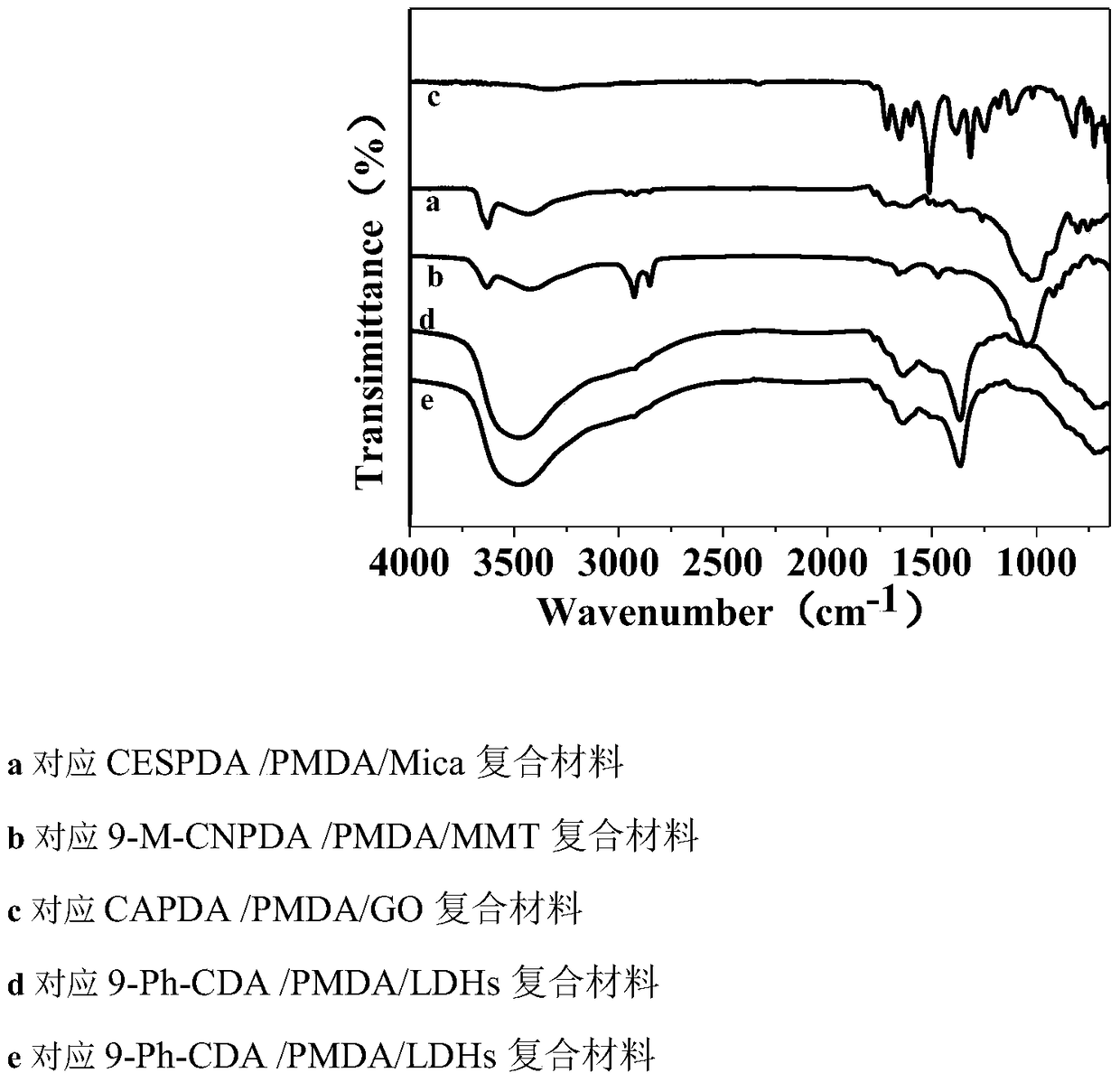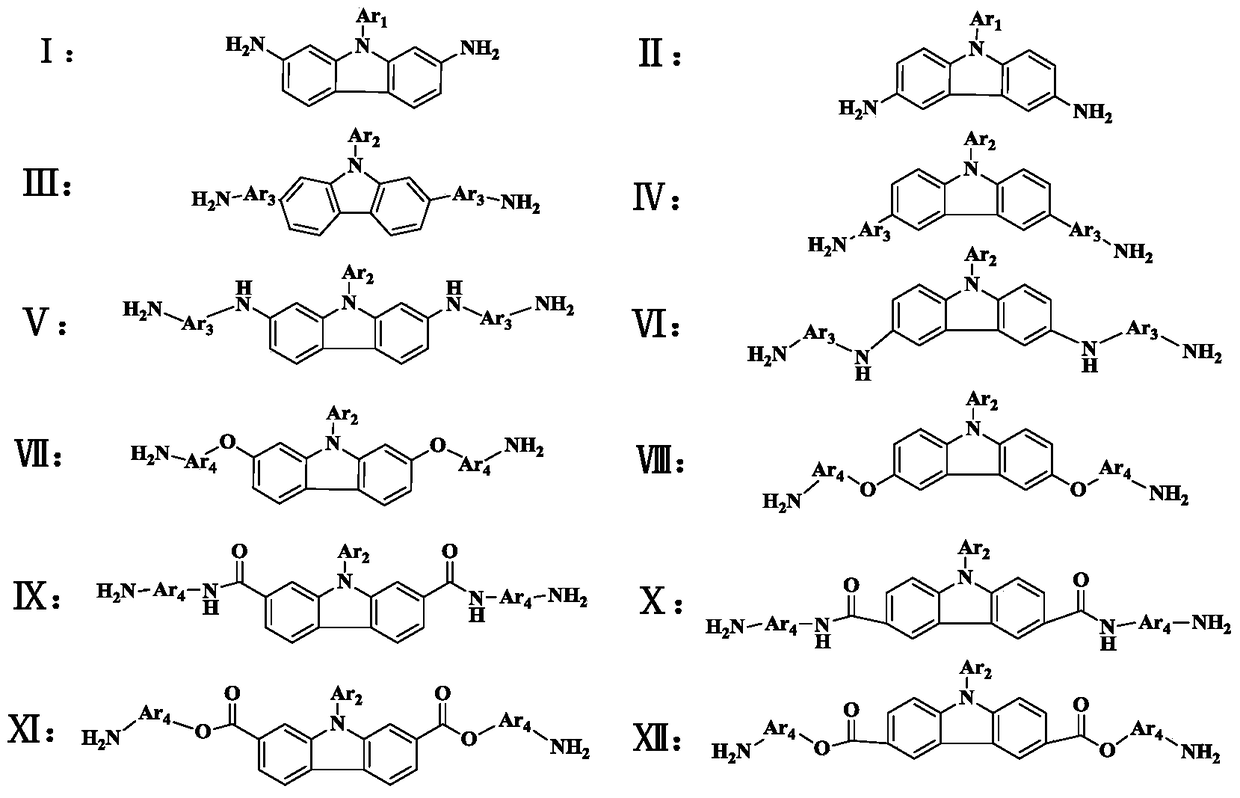A kind of polyimide nanocomposite material containing carbazole structure and its preparation method and application
A technology of nanocomposite materials and polyimide, which is applied in the field of material science to achieve the effects of various preparation processes, low condition requirements, and simple preparation processes
- Summary
- Abstract
- Description
- Claims
- Application Information
AI Technical Summary
Problems solved by technology
Method used
Image
Examples
Embodiment 1
[0042] At room temperature, under an argon atmosphere, 0.20g of mica (Mica) was sonicated in (46.3ml) N,N-dimethylformamide for 1h, and then 4.3745g (0.01mol) of bis(4-aminophenyl)9H- carbazole-3,6-dicarboxylate (CESPDA) and 2.1812g (0.01mol) 1,2,4,5-Benzenetetracarboxylic anhydride (1,2,4,5-pyromellitic dianhydride, PMDA) were added to N,N - In dimethylformamide, the solid content is 10%, and the reaction is stirred for 6 hours to obtain a homogeneous and viscous polyamic acid / mica composite glue. Then scrape and coat the polyamic acid / mica composite glue on the glass plate, then place the glass plate in a vacuum oven, vacuumize, and the temperature rise program is: the room temperature is raised to 100°C and then the temperature is kept constant for 1h→100°C to 200°C After ℃, the whole process of constant temperature is 1h→200℃ to 300℃, the whole process of constant temperature is 1h→300℃ to 400℃, and then the whole process is constant for 1h. After cooling, the polyimide / mi...
Embodiment 2
[0045] At room temperature, under argon atmosphere, 0.18g montmorillonite (MMT) was sonicated in (43.2ml) N,N-dimethylformamide for 2h, and 3.9348g (0.01mol) N1,N1'-(9 -methyl-9H-carbazole-3,6-diyl)bis(benzene-1,4-diamine)(9-M-CNPDA) and 2.1812g(0.01mol)1,2,4,5-Benzenetetracarboxylicanhydride(1,2 , 4,5-pyromellitic dianhydride, PMDA) was added to N,N-dimethylformamide, the solid content was 20%, and the reaction was stirred for 6 hours to obtain a homogeneous viscous polyamic acid / montmorillonite Composite glue. Then scrape and coat the polyamic acid / montmorillonite composite glue on the glass plate, then place the glass plate in a vacuum oven, vacuumize, and the temperature rise program is: the room temperature is raised to 100°C, and then the temperature is kept constant throughout the process for 1h→100°C. The whole process of constant temperature after reaching 200°C is 1h→200°C, temperature rises to 300°C, and the whole process of constant temperature is 1h→300°C, then t...
Embodiment 3
[0048] At room temperature, under an argon atmosphere, 0.03g graphene oxide (GO) was ultrasonicated in (46ml) N-methylpyrrolidone for 6h to obtain a graphene oxide dispersion. At the same time, 4.3548g (0.01mol) N3, N6- bis(4-aminophenyl)-9H-carbazole-3,6-dicarbazole-xamide (CAPDA) and 2.1812g (0.01mol) 1,2,4,5-Benzenetetracarboxylic anhydride (1,2,4,5-pyromylene Formic dianhydride, PMDA) was added to N,N-dimethylformamide, the solid content was 30%, and the reaction was stirred for 6 hours to obtain a homogeneous viscous polyamic acid glue, and then the graphene oxide dispersion was poured into The polyamic acid / graphene oxide composite glue is obtained from the polyamic acid glue. Then scrape and coat the polyamic acid / graphene oxide composite glue on the glass plate, then place the glass plate in a vacuum oven, vacuumize, and the heating program is as follows: after the room temperature is raised to 100°C, the temperature is kept constant throughout the process for 1h→100°C...
PUM
 Login to View More
Login to View More Abstract
Description
Claims
Application Information
 Login to View More
Login to View More - R&D
- Intellectual Property
- Life Sciences
- Materials
- Tech Scout
- Unparalleled Data Quality
- Higher Quality Content
- 60% Fewer Hallucinations
Browse by: Latest US Patents, China's latest patents, Technical Efficacy Thesaurus, Application Domain, Technology Topic, Popular Technical Reports.
© 2025 PatSnap. All rights reserved.Legal|Privacy policy|Modern Slavery Act Transparency Statement|Sitemap|About US| Contact US: help@patsnap.com



